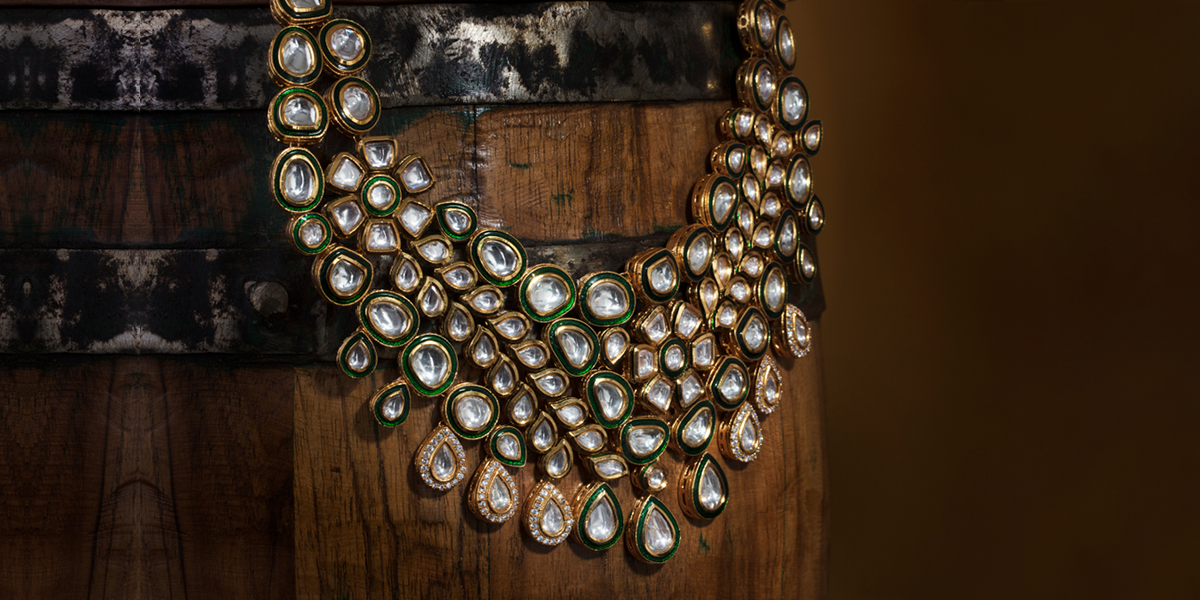The first impression India has on a first time traveller is plethora of colours all around and diversity in every element. From culture and religion to food, art and craft, the scope is innumerable. As we travel from one region to another our food, language, attires, tradition, everything differs. India also takes pride in its rich and diverse range of traditional jewellery. From dazzling gold and sparkling diamond jewellery to beautiful Meenakari, regal Polki and stunning kundan jewellery, each type has its own charisma and appeal. Kundan, considered to be royal as it is believed to have originated in the royal courts of Rajasthan itself, it is one of the ancient art of jewellery embellished with gold foil and gemstones. In addition, referred to as Jaipuri or Bikaneri jewellery, we decided to revisit its rich legacy from past and its current variations.
What is Kundan?
The word “Kundan” refers to highly refined gold. It gets its name from skilful encasing glass or gemstones in a base of gold foil prepared with highly refined and pure form of molten gold. The rich legacy of crafting kundan jewellery is over 2500 years carrying a mark of royal culture and aristocracy of ancient India. One of the oldest forms of jewellery form in India, Kundan is a form of jewellery crafted from gold with a core of wax. Since pure gold is little softer, the whole piece of jewellery cannot be made with 24 Karats, only the jadayi part is done in pure metal, which is finally known as Kundan. The defining attribute of kundan is the setting of precious and semi-precious polished gemstones in layers upon layers to form beautiful shapes and its process of making.
The Origin and History of Kundan in India
Dating back to the era of Rajputs and Mughals, Kundan jewellery is one of the oldest jewellery crafts in India. Brought to the country many centuries ago, the art chiefly flourished in the royal courts of Rajasthan and Gujarat under the patronage of the Mughals from 16th century onwards. Although, craft existed prior to its engagement with Mughals, however, it is believed that many kundan crafting and its setting styles were created in the Delhi court and then passed on to the craftsman of Gujarat and Rajasthan. Kundan ornaments were not only commissioned by the kings and statesman in ancient India but also used as a part of their royal attires and was bejewelled on their royal furniture.
In later years, the art of Kundan Jewellery became an eminent part of royal families. If you visit museums, it is easy to find touches of art and artisanship from the time of Rajputs and Mughals in this kind of jewellery. Today, it is desired by most women and is favoured for special occasions, especially wedding ceremonies.
Process of Making Kundan
For creating a kundan masterpiece, it requires long man-hours and quite a complex process. Every step of creating this jewellery is designated with specialised artisan, as each stage requires a matured skill sets. It begins with making a framework known as ‘Ghat’ in 22-Karat gold, which is called ‘gadhayi’. Depending upon the design, a mould-like framework is set using thin gold strips, which are then cut, coiled and shaped. It is also one of the significant steps to create the groundwork of the piece.
The next step known as ‘Khudayi’, involves etching the outer surface with the patterns or designs as required. Gold or lac (a type of wax) is poured over the framework and then engraved. The process is called Paadh procedure. Uncut, shaped and polished gemstones like diamonds, polkis, emeralds, rubies, sapphries, even glass are then laid upon the framework known as ‘jadayi’.
To fill the gaps, more lac or gold is poured, especially to the edges to give it a polished and neat look. Next is process of ‘pakai, in which gold foils are added to the piece to provide sufficient grip. Lastly, ‘chillai’ is done where gemstones are properly polished for proper sheen. With addition of Meenakari details in engraving on the backside makes the ornaments a reversible wear. However, the outcome of the long hours of hard work is a mesmerising piece of kundan jewellery exuding sheer magic and radiance.
Carrying the antiquity of Kunadn Jewellery in Bhiwani and across the region, JaganNath Jewellers brings thoughtful designs and endless charm to every piece of their Kundan Collection. From compilation of the regal anthology inspired by our heritage and set with contemporary perspective, each kundan jewellery set in Bhawani by JNML Saraf is mesmerising. From intricate gold ornaments to elaborate meenakari art and meticulously carved Kundan jewellery set, our assemblage celebrates the beautiful amalgamation of traditions and modernity.
